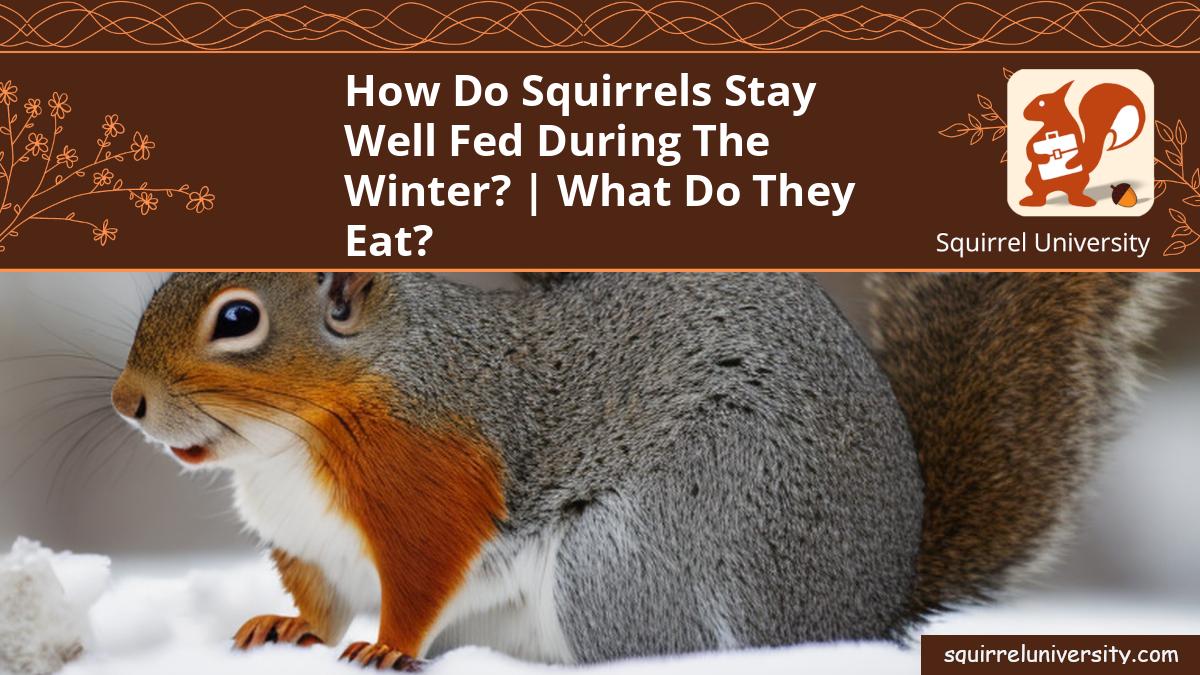As a passionate wildlife enthusiast with extensive experience studying squirrels around the world, I’m excited to discuss how these animals stay well fed during the harsh winter months. As it turns out, the answer is in their diet! So, what do squirrels eat in the winter?
Squirrels eat a variety of items to survive during the winter months. Their diet consists of:
- Nuts, such as acorns and hickory nuts
- Seeds from pine cones, corn cobs, berry bushes and weed heads
- Fruit such as apples, pears and persimmons
We’ll explore what do squirrels eat in the winter and how they sustain themselves through this challenging season.
An Overview of Squirrels’ Winter Dietary Needs
Throughout the winter season, squirrels adjust their diets to survive in the harsher temperatures. They feed on nuts, seeds, and fruits that are available in colder climates and adapt their nutritional needs according to the food sources in their environment. The challenge for squirrels living in cold weather is balance energy intake with expenditure.
As temperatures drop and snow falls, they must eat extra food to keep warm while also stocking up on enough provisions to survive hibernation periods. Understanding the specific dietary requirements of squirrels during these frosty months can help animal lovers properly care for them when there is reduced natural sustenance available outdoors.
What Do Squirrels Eat In Winter?
Nuts, seeds, and fruits make up a large portion of a squirrel’s diet throughout the winter months. This includes acorns from oak or hickory trees as well as pine cones on coniferous plants like fir trees. Nuts provide essential nutrients such as fat and protein which are necessary for survival during cold temperatures when activity levels are reduced due to decreased daylight hours and chillier days ahead.
Additionally, walnuts can be found buried beneath soil or leaf litter providing a steady supply of energy reserves depending on location available near grasses or shrubs near your home or backyard. Fruits such as apples, berries (especially blueberries), persimmons; pears; plums; apricots; strawberries; raspberries; blackberries can often be spotted hiding under tree branches or scattered around bird feeders providing occasional snacks during active times outside seeking potential mates or resources while avoiding potential predators lurking nearby.
Nuts, Seeds & Fruits
Squirrels are ingenious creatures with a knack for securing food during the winter months when food sources can be scarce. Luckily, they love to snack on nuts, seeds, and fruits! A typical squirrel diet includes acorns, walnuts, hazelnuts and pine nuts. They also favor sunflower seeds, peanuts and other nuts. Additionally, in late summer season squirrels indulge in apples, plums and some berries.
In order to stay nourished during the cold months of winter, squirrels often hide their favorite snacks around their homes or bury them in special hiding spots until needed. Because of this clever strategy they rarely have difficulty finding sustenance even during the harshest temperature drops!
Nutritional Requirements for Survival in the Wild During Winter Months
In order to survive the winter months, squirrels must ensure that their diet is balanced, with enough energy-rich food sources to sustain them through periods of hibernation and cold weather. In addition to providing sustenance, a comprehensive winter diet should also provide a variety of essential vitamins and minerals.
Squirrels require a certain amount of fat in their diets as well as protein. Nuts, seeds, fruits and vegetables are all important sources of dietary fats and proteins for squirrels during wintertime. While some will happily munch on dried berries or nuts they stored away during summer months, much of a squirrel’s diet still comes down to scavenging or preying upon insect larvae found beneath tree bark.
Balancing energy intake and expenditure
Squirrels must seek out sources of nourishment to maintain balance between energy intake and expenditure during the winter months. They rely on their stored fat reserves for sustenance, as well as eating acorns, nuts, fungi, insects, fruits and flowers. Furthermore, it is important for squirrels to remain physically active throughout the cold season in order to avoid becoming too sedentary and conserve energy within their body.
“Squirrelling Away” Provisions for Winter Hibernation
The process of storing provisions before entering into hibernation is often referred to as “squirrelling away”. This can involve hiding extra food around the home or local neighbourhood such as burying nuts in small holes around trees or items left out in areas where species like grey squirrels are known to gather.
Providing an ideal environment for food storage requires meeting two key criteria; protection from predators; and insulation against environmental fluctuations such as temperature changes. To this end, grey squirrels often select natural cavities like tree hollows and trunks that provide ample space for stashing these precious provisions.
Tricks & Tips for Keeping Squirrels Fed During Wintertime
In addition to providing seeds or special treats at birdfeeders throughout each season, there are other practical strategies that can be used by home owners looking to support wildlife populations. Traps, both live traps set outdoors or traditional snap traps placed inside dwellings, provide an effective way of catching rodents without harm. As long as proper safety precautions are taken when handling trapped animals, this is generally considered an acceptable method of managing pest populations.
- Place feeders near trees – Offer seed mix in hopper style feeders located close to trees if possible. Since tree cover serves an important role in helping squirrels feel secure while they’re eating by allowing them quick access back into the branches when danger appears, this provides an ideal location come meal time.
- Encourage natural foraging behaviour – Supplementing feeder birds‘ diets with fresh fruit, vegetables and peanut butter may entice wild animals close enough so that home owners can observe them more closely which offers insights into how they behave naturally.
- Wildlife friendly landscaping techniques – Installing native plants helps bring additional value beyond aesthetics because not only do they attract more pollinators; but different varieties also offer up acorns which can enrich your garden activities with enticing seasonal fare such as corn cobs mixed with peanuts.
Preparing for Winter: Storing Food Supplies
As winter approaches, squirrels engage in a variety of complicated resource-gathering behaviors to ensure they have enough food when cold weather sets in. This includes understanding their own nutritional needs and stocking up on supplies to last them through the coldest months. In order to survive during the winter, it is essential that squirrels have enough stored away food.
One of the most important elements of preparing for winter is understanding the different ways squirrels store up food for later use. Squirrels are adept hoarders and will spend much time digging and burying various types of nuts and seeds – something known as “scatter hoarding” – around their habitat. This allows them to access buried caches when food sources are scarce or difficult to access.
Understanding the Squirrel’s Winter Stash-Building Habits
Scatter-hoarding behaviors vary depending on the species, but all involve gathering more resources than necessary so that some can be saved for later times of need. For example, red squirrels gather large quantities of nuts over summer which they bury at various locations throughout autumn before hibernation begins in December.
Other animals, like grey squirrels, practice “larder hoarding” by finding hiding places where they store up large amounts of food so that they do not need to constantly travel back and forth between trees and caches while scavenging for sustenance. Both scatter hoarding and larder hoarding techniques are used as means to reduce energy expenditure while ensuring there is always a supply available in case conditions get worse.
Because some larger predators view buried caches as potential meals, careful thought must be put into where these stashes will be located such that safety from other animals is ensured whenever possible. Grey squirrels specifically seek very tight spaces with multiple exits since this can provide further protection from predators on their way out after retrieving hidden goods.
Aside from avoiding predation risk from external threats it is also beneficial for scavengers themselves if their larders remain unseen by others since competition could cause serious consequences due to limited supplies during wintertime.
The importance of storing food in a safe, secure location
Storing food in a safe and secure location is essential for any squirrel to survive the winter. Not only will it help ensure their energy needs are met, but it will protect them from hungry predators that may intrude upon their territory. A good strategy would be to store food in higher places, like trees or thickets, where rodents cannot easily access it. Additionally, keeping food supplies dry and away from snow will be key to maintaining its quality and helping preserve its nutritional value throughout the colder months!
“Scatter hoarding” tactics: burying and caching food around an area as a backup plan.
Squirrels deploy a variety of “scatter hoarding” tactics to stay well-fed throughout the winter. These strategies involve burying and caching food in different spots around an area as a backup plan. This method allows them to quickly locate food when they need it, ensuring that they don’t go hungry during harsh weather conditions.
Conclusion
Overall, it is clear that squirrels have many strategies, like storing and seeking out different food sources to help them through the winter. With a variety of options from nuts and seeds to mushrooms and bark, depending on the species and region, squirrels are pretty well equipped for dealing with the colder temperatures. While there are some food sources that may be harder to come by during this time of year, if squirrels stock up early enough and work hard enough they won’t go hungry.
Knowing what do squirrels eat in the winter is key in understanding their behavior. By having a variety of options available, they can easily survive until spring arrives so they can begin gathering food once again. It’s thought that using these methods together is how wild or even domesticated squirrels manage to stay well fed during colder months.
You may also be interested in reading:

